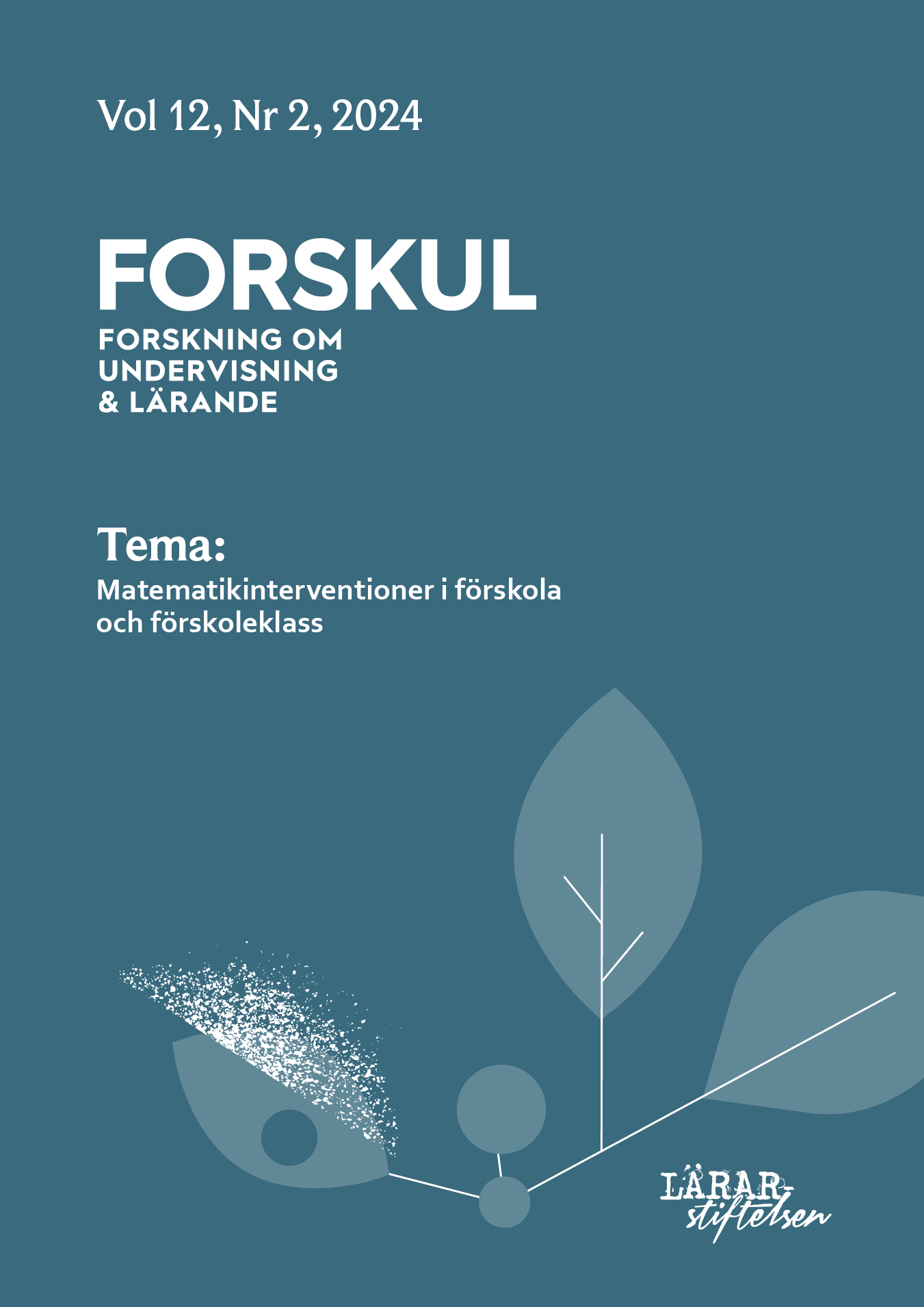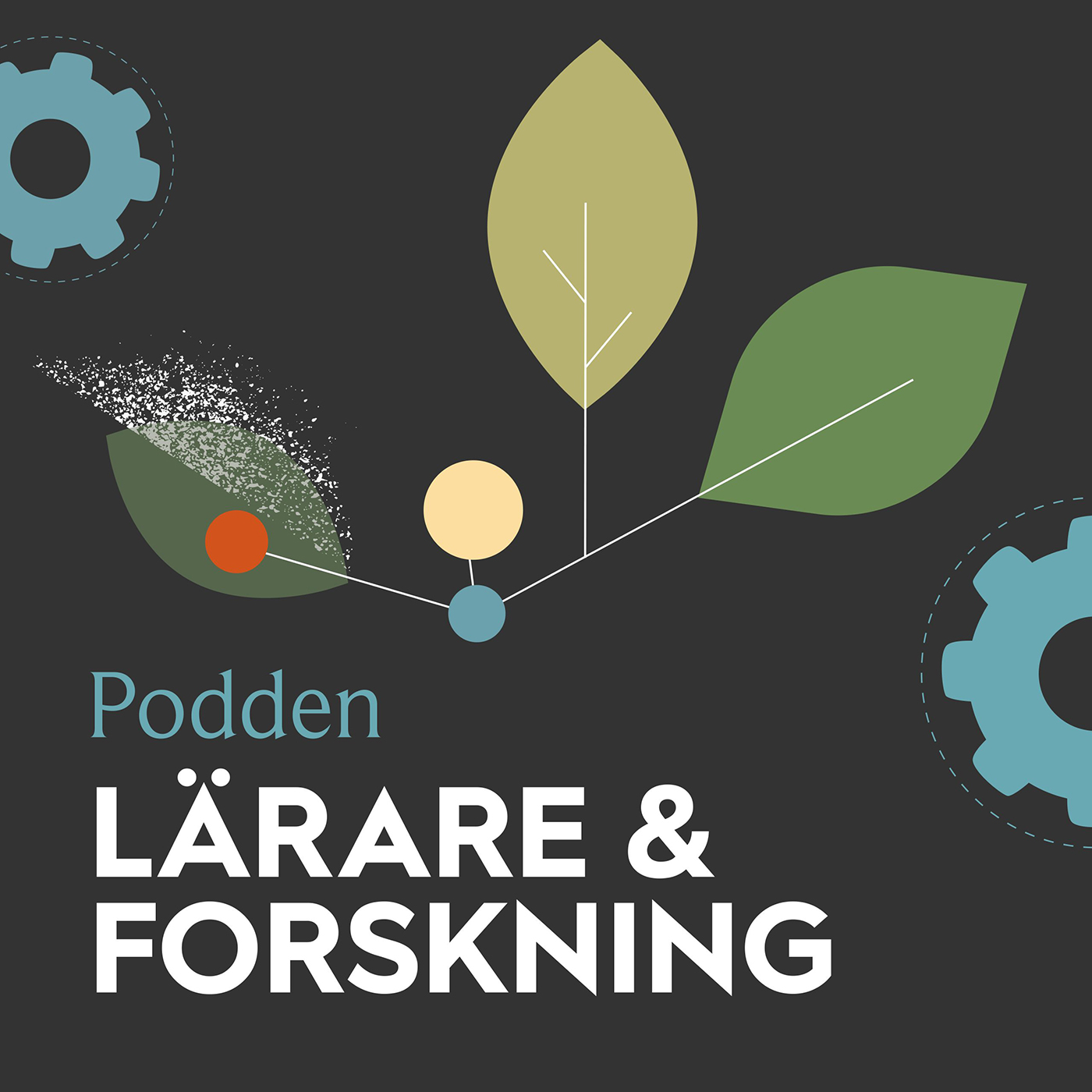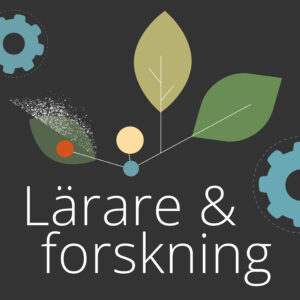Division i förskoleklassen genom problemlösning och problemformulering
DOI:
https://doi.org/10.61998/forskul.v12i2.23893Nyckelord:
problemlösning, problemformulering, förskoleklass, division, designforskningAbstract
I denna studie arbetade förskoleklasselever med division genom problemlösning och problemformulering. Data kommer från en undervisningsaktivitet uppdelad på två tillfällen. Aktiviteten planerades i samarbete mellan förskoleklasslärare och forskare och genomfördes i 11 förskoleklasser med 205 elever. Vid problemlösning urskilde eleverna relationen mellan helhet och delar, storleken på varje del, dela som division samt kontinuerlig och diskret mängd som aspekter av division. Vid problemformulering återkom dessa aspekter samt tillkom aspekten att täljaren kan vara ett rationellt tal. Utöver dessa aspekter av division formulerade eleverna till exempel uppgifter med en liknande kontext (kakor) men med ett annat matematikinnehåll (till exempel subtraktion). Då det finns få studier om problemlösning och problemformulering med yngre elever bidrar denna studie med kunskap av värde för både (förskoleklass)lärare och forskare.
Division in preschool class through problem solving and problem posingIn this study, preschool-class students worked with problem solving and problem posing on division. Data comes from an activity divided into two sessions. The activity was planned in collaboration between preschool-class teachers and researchers and carried out in 11 preschool classes with 205 students. While solving problems, students distinguished the relationship between the parts and whole, the size of each part, dividing as division and continuous and discrete quantities as aspects of division. While posing problems, these aspects reappeared as well as the aspect that the numerator can be a rational number. Apart from problems on division, the students posed problems with a similar context (cookies) but a different mathematical content (e.g., subtraction). As there are few studies on problem solving and problem posing with younger students, this study contributes with knowledge of value to both (preschool class) teachers and researchers.
Referenser
Bakker, A. (2018). Design research in education: A practical guide for early career researchers. Routledge. https://doi.org/10.4324/9780203701010
Björklund, C. & Runesson Kempe, U. (2020). Utveckling av räknefärdigheter hos fem-till sjuåringar: Matteuseffekt eller utfall av undervisning. Forskning om undervisning och lärande, 8(1), 9–28.
Cai, J. & Hwang, S. (2020). Learning to teach through mathematical problem posing: Theoretical considerations, methodology, and directions for future research. International Journal of Educational Research, 102, 101391. https://doi.org/10.1016/j.ijer.2019.01.001
Cai, J., Hwang, C., Jiang, C. & Silber, S. (2015). Problem-posing research in mathematics education: Some answered and unanswered questions. I F. M. Singer, N. Ellerton & J. Cai (Red.), Mathematical problem posing: From research to effective practice (s. 3–34). Springer. https://doi.org/10.1007/978-1-4614-6258-3_1
Carrillo, J. & Cruz, J. (2016). Problem-posing and questioning: Two tools to help solve problems. I P. Felmer, E. Pehkonen & J. Kilpatrick (Red.), Posing and solving mathematical problems: Advances and new perspectives (s. 23–36). Springer. https://doi.org/10.1007/978-3-319-28023-3_2
Chen, L., Van Dooren, W. & Verschaffel, L. (2013). The relationship between students’ problem posing and problem solving abilities and beliefs: A small-scale study with Chinese elementary school children. Frontiers of Education China, 8(1), 147–161. https://doi.org/10.1007/BF03396966
Ching, B. H. H. & Wu, H. X. (2021). Young children’s knowledge of fair sharing as an informal basis for understanding division: A latent profile analysis. Learning and Instruction, 73, 101460. https://doi.org/10.1016/j.learninstruc.2021.101460
Cifarelli, V.V. & Sevim, V. (2015). Problem posing as reformulation and sense-making within problem solving. I F.M. Singer, N.F. Ellerton & J. Cai (Red.), Mathematical Problem Posing: From Research to Effective Practice (s. 177–194). Springer
Correa, J., Nunes, T. & Bryant, P. (1998). Young children's understanding of division: The relationship between division terms in a noncomputational task. Journal of Educational Psychology, 90(2), 321–329. https://doi.org/10.1037/0022-0663.90.2.3211
Dehaene, S. (1997). The number sense: How the mind creates mathematics. Oxford University Press.
Ebbelind, A., Palmér, H. & van Bommel, J. (2023) Experience a sense of being, becoming and belonging to an educational design project as professional development. I P. Drijvers, C. Csapodi, H. Palmér, K. Gosztonyi & E. Kónya (Red.), Proceedings of the Thirteenth Congress of the European Society for Research in Mathematics Education (CERME13) (s. 3187–3194). Alfréd Rényi Institute of Mathematics and ERME.
Ellerton, N. F., Singer, F. M. & Cai, J. (2015). Problem posing in mathematics: Reflecting on the past, energizing the present and foreshadowing the future. I F. M. Singer & N. F. Ellerton (Red.), Mathematical problem posing: From research to effective practice (s. 547–556). Springer. https://doi.org/10.1007/978-1-4614-6258-3_26
Empson, S. B. (1999). Equal sharing and shared meaning: The development of fraction concepts in a first grade classroom. Cognition and Instruction, 17(3), 283–342. http://www.jstor.org/stable/3233836
English, L. & Sriraman, B. (2010). Problem Solving for the 21st Century. I B. Sriraman & L. English (Red.), Theories of mathematics education: Seeking new frontiers (s. 263–290). Springer.
European commission, directorate-general for education, youth, sport and culture. (2019). Key competences for lifelong learning. Publications Office. https://doi.org/10.2766/569540
Frydman, O. & Bryant, P. (1988). Sharing and the understanding of number equivalence by young children. Cognitive Development, 3(4), 323–339. https://doi.org/10.1016/0885-2014(88)90019-6
Gunderson, A. G. (1955). Thought-patterns of young children in learning multiplication and division. The Elementary School Journal, 55(8), 453–461. https://doi.org/10.1086/458721
Hansson, H. (2019). Betydelsen av att variera innehållsliga aspekter för yngre elevers lärande av platsvärde. Forskning om undervisning och lärande, 7(3), 48–74.
Klaassen, K. & Doorman, M. (2015). Problem posing as providing students with content-specific motives. I F.M. Singer, N.F. Ellerton & J. Cai (Red.), Mathematical problem posing: From research to effective practice (s. 177–194). Springer
Khalid, M., Saad, S., Abdul Hamid, S.R., Ridhuan Abdullah, M., Ibrahim, H. & Shahrill, M. (2020). Enhancing creativity and problem solving skills through creative problem solving in teaching mathematics. Creativity Studies, 13(2), 270–291. https://doi.10.3846/cs.2020.11027
Legare, C. H., Mills, C. M., Souza, A. L., Plummer, L. E. & Yasskin, R. (2013). The use of questions as problem-solving strategies during early childhood. Journal of Experimental Child Psychology, 114(1), 63–76. https://doi.org/10.1016/j.jecp.2012.07.002
Lesh, R. & Zawojewski, J. (2007). Problem solving and modelling. I F. K. Lester (Red.), Second handbook of research on mathematics teaching and learning (s. 763–799). National Council of Teachers of Mathematics and Information Age Publishing.
Marton, F. (2014). Necessary conditions of learning. Routledge. https://doi.org/10.4324/9781315816876
Marton, F. & Booth, S. (1997). Learning and awareness. Lawrence Erlbaum Associates. https://doi.org/10.4324/9781315816876
Marton, F. & Pang, M. F. (2006). On some necessary conditions of learning. The Journal of the Learning Sciences, 15(2), 193–220. https://doi.org/10.1207/s15327809jls1502_2
Matalliotaki, E. (2012). Resolution of division problems by young children: What are children capable of and under which conditions? European Early Childhood Education Research Journal, 20(2), 283–299. https://doi.org/10.1080/1350293x.2012.681132
Neuman, D. (1999) Early learning and awareness of division: A phenomenographic approach. Educational Studies in Mathematics, 40(2), 101–128. https://doi.org/10.1023/A:1003852815160
Palmér, H. (2008). Är ett halvt kex lika många som ett helt kex? I I. Pramling Samuelsson & N. Pramling (Red.), Didaktiska Studier från förskola och skola (s. 19–40). Gleerups Utbildning AB.
Palmér, H. & van Bommel, J. (2018). Young students’ feelings towards problem solving tasks: What does “success” imply? I B. Rott, G. Törner, J. Peters-Dasdemir, A. Möller & Safrudiannur (Red.), Views and beliefs in mathematics education: The role of beliefs in the classroom (s. 69–78). https://doi.org/10.1007/978-3-030-01273-1_7
Palmér, H. & van Bommel, J. (2020). Young students posing problem-solving tasks: What does posing a similar task imply to students? ZDM Mathematics Education, 52(4), 743–752. https://doi.org/10.1007/s11858-020-01129-x
Palmér, H. & van Bommel, J. (2021). Teachers' participation in practice based research: A methodological retrospect. Nordic Studies in Mathematics Education, 26(3–4), 113–130.
Palmér, H. & van Bommel, J. (2023). Young Students Exploring Measurement Through Problem Solving and Problem Posing. The Mathematics Educator, 31(1), 30–54.
Parmar, R. S. (2003). Understanding the concept of ”division”: Assessment considerations. Exceptionality, 11(3), 177–189. https://doi.org/10.1207/S15327035EX1103_05
Pehkonen, E., Näveri, L. & Laine, A. (2013). On teaching problem solving in school mathematics. CEPS Journal, 3(4), 9–23. https://doi.org/10.25656/01:8498
Pramling, N. & Pramling Samuelsson, I. (2008). Identifying and solving problems: Making sense of basic mathematics through storytelling in the preschool class. International Journal of Early Childhood, 40(1), 65–79. https://doi.org/10.1007/BF03168364
Silver, E. A. (1994). On mathematical problem posing. For the Learning of Mathematics Education, 27(3), 293–309. https://www.jstor.org/stable/40248099
Singer, F. M., Ellerton, N. & Cai, J. (2013). Problem-posing research in mathematics education: New questions and directions. Educational Studies in Mathematics, 83(1), 1–7. https://doi.org/10.1007/s10649-013-9478-2
Skolverket. (2022). Läroplanen för grundskolan, förskoleklassen och fritidshemmet (Lgr22). https://www.skolverket.se/getFile?file=9718
Stein, M. K., Engle, R. A., Smith, M. S. & Hughes, E. K. (2008). Orchestrating productive mathematical discussions: Five practices for helping teachers move beyond show and tell. Mathematical Thinking and Learning, 10(4), 313–340. https://doi.org/10.1080/10986060802229675
Stjernlöf, J. & Fred, J. (2014). Uppgifter som redskap för mediering av kritiska aspekter i matematikundervisning. Forskning om undervisning och lärande, (12), 21–43.
Stoyanova, E. & Ellerton, N. F. (1996). A framework for research into students’ problem posing. I P. Clarkson (Red.), Technology in mathematics education (s. 518-525). Mathematics Education Research Group of Australasia.
Sumpter, L. & Hedefalk, M. (2023). När dela lika är olika. Nordisk barnehageforskning, 20(2), 110–129.
Tarim, K. (2009). The effects of cooperative learning on preschoolers’ mathematics problem-solving ability. Educational Studies in Mathematics, 72(3), 325–340. https://doi.org/10.1007/s10649-009-9197-x
van Bommel, J. & Palmér, H. (2016). Young children exploring probability: With focus on their documentations. Nordic Studies in Mathematics Education, 21(4), 95–114.
van Bommel, J. & Palmér, H. (2021). Young students’ views on problem solving versus problem posing. Journal of Childhood, Education & Society, 2(1), 1–13. https://doi.org/10.37291/2717638x.20212165
van Bommel, J. & Palmér, H. (2022) Dividing cookies: What do students discern? I L. Mattsson, J. Häggström, M. Carlsen, C. Kilhamn, H. Palmér, M. Perez & K. Pettersson (Red.), The relation between mathematics education research and teachers’ professional development. The thirteenth research seminar of the Swedish Society for Research in Mathematics Education, Växjö (s. 33–44). Svensk förening för MatematikDidaktisk Forskning - SMDF.
Vetenskapsrådet (2017). God forskningssed. [Elektronisk resurs]
Wyndhamn. J., Riesbeck, E. & Schoultz, J. (2000). Problemlösning som metafor och praktik. Linköpings universitet.
Publicerad
Referera så här
Nummer
Sektion
Kategorier
Licens
Copyright (c) 2024 Jorryt van Bommel, Hanna Palmér, Andreas Ebbelind

Det här verket är licensierat under en Creative Commons Erkännande 4.0 Internationell-licens.
Författare till innehåll publicerat i Forskul behåller upphovsrätten till sina verk. Artiklar publiceras under villkoren i en Creative Commons-licens CC BY, som tillåter användning, nedladdning, distribution, länkning till och reproduktion i vilket medium som helst, förutsatt att originalverket är korrekt citerat.






